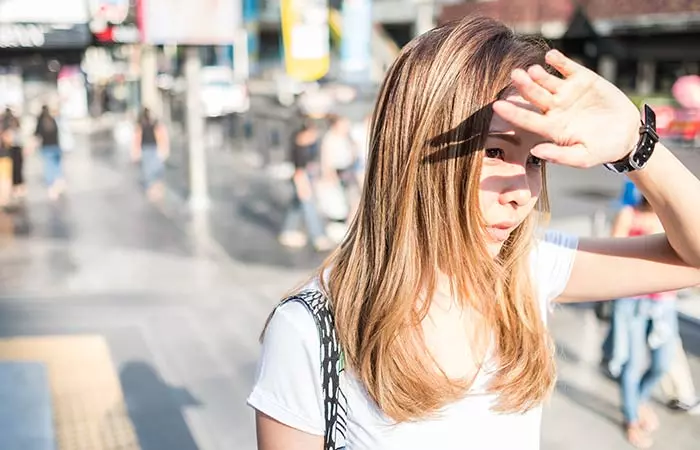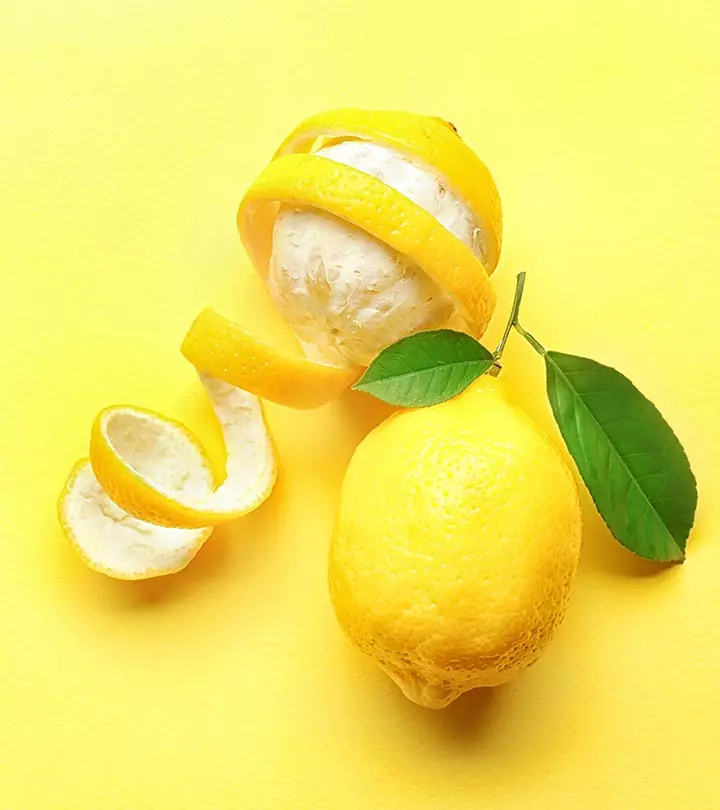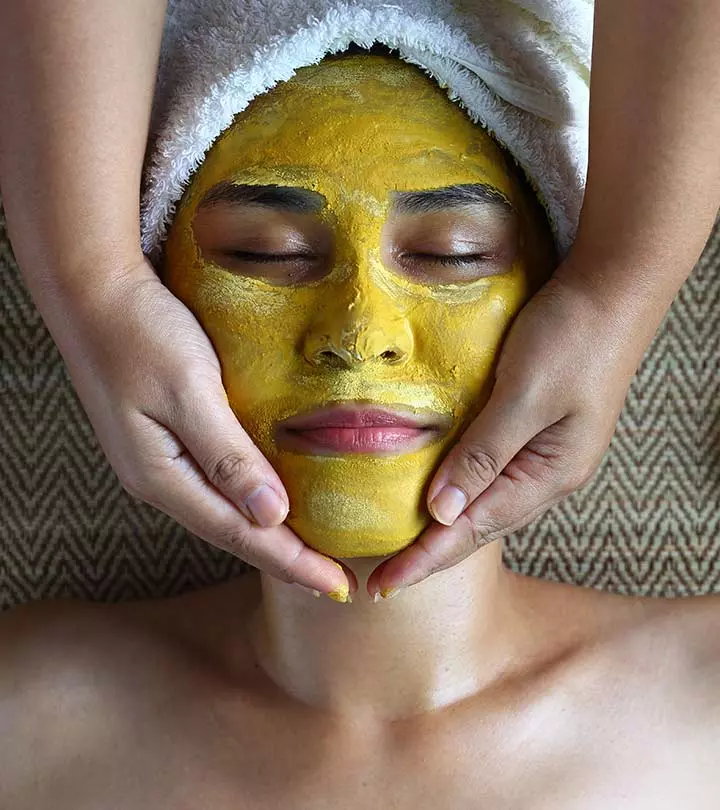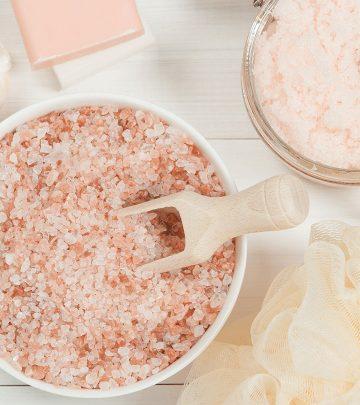Alpha Hydroxy Acids: 8 Skin Benefits, Risks, And How To Use
Say goodbye to the signs of aging and improve the texture of your skin!

Image: Shutterstock
If you are unaware of the benefits of alpha-hydroxy acids for your skin and haven’t used them, you are missing out on a great ingredient. These acids naturally occur in fruits and are used in skin care to exfoliate, reduce pigmentation, fade visible signs of aging, and improve skin texture. Scroll through this article to learn more about alpha-hydroxy acids, their benefits, and their risks.

In This Article
What Are Alpha Hydroxy Acids (AHAs)?

Alpha Hydroxy Acids or AHAs are a group of naturally occurring chemical compounds. AHAs are derived from animal or plant products (such as fruits and milk). They are commonly used in anti-aging skin care products as these acids help in reducing signs of aging (such as wrinkles, dark spots, and fine lines) and improve the skin texture and elasticity (1).
There are seven types of AHAs that you will find in various skin care products. These are:
- Glycolic Acid (derived from sugar cane)
- Citric Acid (derived from citrus fruits)
- Lactic Acid (derived from lactose)
- Hydroxycaproic Acid (derived from royal jelly, secreted by honey bees)
- Malic Acid (derived from fruits such as pears and apples)
- Hydroxycaprylic Acid (derived from animals)
- Tartaric Acid (derived from grapes)
 Trivia
TriviaOut of all these AHAs, only a few, such as glycolic and lactic acids, are widely used in skin care products. And that’s why these two AHAs are extensively studied by researchers for their various effects and benefits. Usually, AHAs (glycolic and lactic acids) are gentle on the skin and do not cause any irritation. These acids act as chemical exfoliants. They dissolve the intercellular bonds (the bonds between your skin cells) and facilitate the natural shedding process of your skin, helping you get rid of the dead skin cells easily, revealing softer, smoother, and brighter skin. Let’s take a look at the benefits of AHAs for your skin.
Key Takeaways
- Alpha hydroxy acids used in skin care products help reduce wrinkles and dark spots
- BHA’s main source is salicylic acid and since it is oil-soluble, it is suitable for people with sensitive skin and acne-prone skin.
- Glycolic acids improve skin texture by getting rid of dead skin cells.
- Due to their ease of skin penetration, AHAs are used to treat hyperpigmentation.
Benefits Of Alpha Hydroxy Acids (AHAs)
1. AHAs Are The Best Exfoliators For Your Skin

The process of cell turnover, shedding and regeneration of cells, is a continuous cycle. However, when you age, this process slows down. As a result, dead skin cells accumulate on your skin. This makes your skin dark and dull and also causes age spots. AHAs help your skin in its natural process of shedding dead skin cells (2).
2. Make Your Skin Bright
When your skin sheds the dead cells, it reveals a fresh layer of cells beneath. Your skin automatically appears fresh, plump, full of radiance, and more elastic.
3. AHAs Boost Collagen Expression

Collagen is the fiber that keeps your skin looking young and smooth. As you age, the collagen production in your skin decreases, resulting in decreased smoothness of the skin. Also, photodamage caused by excessive sun exposure and environmental damage further affects collagen synthesis. AHAs help in collagen regeneration by eliminating the old collagen fibers (1).
4. Reduce Wrinkles And Fine Lines
AHAs work on wrinkles and fine lines and reduce their appearance. A study involving 52 volunteers between the ages of 30 and 55 years were given topical products containing AHAs. They were studied for 21 days, and significant improvement in their skin texture was noted at the end of the study (1).
5. Help In Reducing Hyperpigmentation

AHAs such as glycolic acid and lactic acid help in reducing hyperpigmentation, dark spots, and melasmai A condition in which patches on the skin darker than the skin tone form due to hormonal changes or sun exposure. . Both these acids are commonly used in chemical peels and other dermatological procedures for treating dark spots. Glycolic acid is usually used to treat freckles and hyperpigmentation because it can penetrate the skin easily (3). Lactic acid is used to treat melasmai A condition in which patches on the skin darker than the skin tone form due to hormonal changes or sun exposure. and has shown good results (4).
AHAs can transform your skin with regular use by promoting a more even distribution of melanin, which is the pigment responsible for skin color. They can help fade dark spots and uneven tones, leaving you with a brighter, clearer complexion.
6. Help Treat Acne
AHAs also help treat mild to moderate levels of acne. Clogged skin pores cause acne, and AHAs can help remove the clogs through exfoliation. They also prevent any further clogging. A study on 248 patients with mild to moderate acne showed the high efficacy of AHAs in providing relief from acne (5).
7. Improve The Efficacy Of Your Products
AHAs can penetrate your skin and break the layer of dead skin cells. This layer of dead cells prevents topical skin creams from being absorbed within the deep layers of your skin. Once the layer is cleared, your skin’s absorption levels increase.
8. Minimize Sun Damage

Exposure to the sun can cause substantial damage to your skin – like dark spots, tanning, wrinkles, and hyperpigmentation. Using AHAs can minimize the effects of sun exposure on your skin.
 Quick Tip
Quick TipThe US Food and Drug Administration (FDA) had conducted thorough research on the usage of AHAs for skin care. AHAs are safe to be used on the skin as long as you follow the directions and use them appropriately. If you are wondering how much of AHAs is right for your skin, FDA has guidelines for that as well. It recommends using products in which the concentration of AHAs is less than 10% (6). This is to avoid any side effects. If not used properly, AHA can have severe side effects.
Alpha Hydroxy Acid Side Effects And Risks
Alpha hydroxy acids usually do not cause any major skin issues. However, if you are using them for the first time, you may experience issues such as:
- Redness
- Swelling
- Itching
- Burning sensation
- Skin discoloration
- Dermatitisi A broad medical term used to describe various types of skin irritation that cause dryness, itchiness, swelling, and rashes.
Alpha hydroxy acids make the skin photosensitive and cause sunburn. That’s why the FDA suggests using sunscreen and limiting sun exposure while using AHA products (6). Also, consult a dermatologist before using AHAs if you have:
- Psoriasisi An autoimmune skin condition with no cure that causes inflammation and dry, itchy, and scaly patches on the skin.
- Eczemai A common skin condition that causes itchiness and inflammation due to stress or exposure to an allergen.
- Rosaceai A common skin condition that causes redness and pimples (small pus-filled bumps) on the skin, usually the face.
- Skin rashes
Avoid applying AHAs on irritated skin or if you have wounds and cuts. Also, pregnant and lactating women should consult a doctor before using products containing AHAs.
Apart from AHA, there is another type of hydroxy acid that is commonly found in skin care products – beta hydroxy acid or BHA. Both are quite similar, but there’s a subtle difference. Keep scrolling to find out.
What Is The Difference Between AHAs And BHAs?
Understanding the differences between AHAs vs. BHAs will help you know which one best suits your skin care needs. Both AHAs and BHAs do the same thing. They make your skin smooth, reduce signs of aging, and give you an even skin tone. However, unlike AHAs, BHAs are not derived from natural ingredients. They are mainly derived from salicylic acid. Unlike AHAs, which are water-soluble, BHAs are oil-soluble, and that’s why they are apt for people with normal to dry skin.
Kalira Tanlongo, a blogger, shared her experience of using salicylic acid for her skin on her personal blog: “It was a great option for me as my skin care goal at the time was to reduce my breakout rate as much as I could, especially as it has been said to be most suitable for oily and acne prone skin (i).” She added, “Because I had oily skin, I knew I had to give salicylic acid a shot. What I loved about this product was the fact that it works to go deep into the pores while unclogging them.”
Compared to AHAs, BHAs are less irritating to the skin and are best suited for those with sensitive skin and acne-prone skin. However, if you have multiple skin issues and also have age-related concerns, AHA products are best for you. But how do you use AHAs for your skin? Let’s find out in the following section.
How To Use AHAs In Skin Care?
You can use alpha hydroxy acids (AHAs) in different ways. They are available in moisturizers, cleansers, toners, or serums. Some AHA skin care products can be washed off, while others must be left on the skin. However, it is important to consider your skin type before choosing products with AHAs for your skin.
If you are new to using these products, start with a low concentration and gradually increase it to avoid adverse effects. AHAs can be drying, so it is important to follow up with a moisturizer. Always follow the instructions provided by the manufacturers, and remember to conduct a patch test.
Infographic: The Amazing Skin Benefits Of Alpha Hydroxy Acids (AHAs)
Alpha hydroxy acids (AHAs) are naturally occurring acids that offer important skin benefits. These can be the ideal solution if you are dealing with acne, discoloration, or melasma. In the infographic below, we have listed the most effective benefits these acids can offer to your skin. Check it out now!
Some thing wrong with infographic shortcode. please verify shortcode syntaxAlpha-hydroxy acids are naturally occurring acids derived from animal and plant products. The benefits of alpha-hydroxy acids for your skin are plenty, as they help reduce the appearance of aging signs like fine lines, wrinkles, and dark spots, improve the skin texture and restore elasticity. Though there are seven types of alpha-hydroxy acids, glycolic and lactic acids are widely used in skin care products. They help exfoliate, lighten the skin, boost collagen, reduce hyperpigmentation, treat acne, and prevent sun damage. Though they are safe for your skin, you may experience a few side effects if you are using them for the first time. Therefore, follow the instructions carefully before using them.
Frequently Asked Questions
Can I use beta hydroxy acids every day?
Though beta hydroxy acids are safe to use on the skin, it is best to start using them twice per week. A comprehensive skincare acid guide will help you choose the right AHAs and BHAs for your skin type.
Can you use beta hydroxy with hyaluronic acid?
Yes, you can use beta hydroxy with hyaluronic acid to provide moisturization, which helps improve skin hydration.
Can I use alpha hydroxy acid with retinol?
AHA and retinol do not always work well together. So, it is best to avoid using them together. You may use AHA in the morning and retinol at night.
Illustration: Amazing Benefits Of Alpha Hydroxy Acid For Your Skin

Image: Dall·E/StyleCraze Design Team
Learn about alpha hydroxy acids (AHAs) like glycolic and lactic acids! Dive into this video to find out when and how to use them, as experts advise.
Personal Experience: Source
StyleCraze's articles are interwoven with authentic personal narratives that provide depth and resonance to our content. Below are the sources of the personal accounts referenced in this article.
i. Skincare Acids and Me!https://adiandbolga.medium.com/skincare-acids-and-me-8d6896b5cfa0
References
Articles on StyleCraze are backed by verified information from peer-reviewed and academic research papers, reputed organizations, research institutions, and medical associations to ensure accuracy and relevance. Read our editorial policy to learn more.
- “An antiaging skin care system..“, Clinical, Cosmetic and Investigational Dermatology, US National Library of Medicine
- “Applications of hydroxy acids..”, Clinical, Cosmetic and Investigational Dermatology, US National Library of Medicine
- “Glycolic acid peel therapy..”, Clinical, Cosmetic and Investigational Dermatology, US National Library of Medicine
- “Chemical Peels for Melasma..”, Journal of Cutaneous and Aesthetic Surgery, US National Library of Medicine
- “Efficacy of an alpha-hydroxy acid..”, Giornale Italianodi Dermatologia e Venereologia, US National Library of Medicine
- “Alpha Hydroxy Acids”, U.S Food & Drug Administration
Read full bio of Dr. Zeel Gandhi
Read full bio of Ramona Sinha
Read full bio of Eshna Das
Read full bio of Shiboli Chakraborti



























Community Experiences
Join the conversation and become a part of our empowering community! Share your stories, experiences, and insights to connect with other beauty, lifestyle, and health enthusiasts.